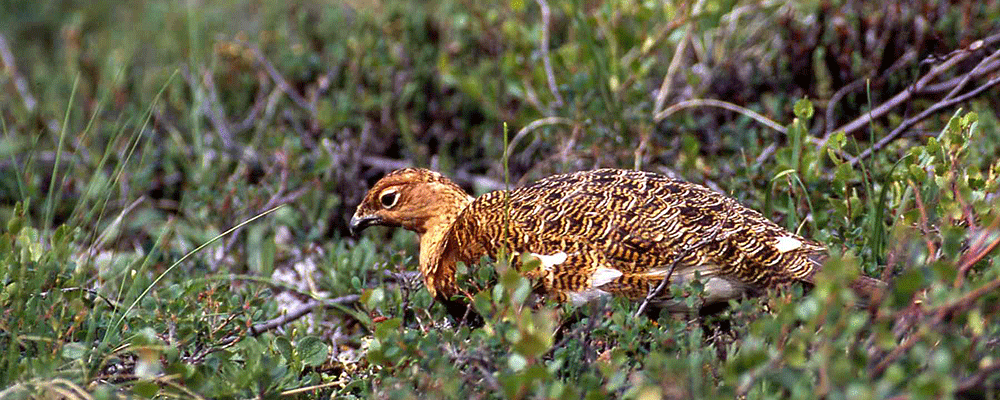Sounds Wild
e-Library Multimedia

Grouse & Ptarmigan
Alaska's Exploding Chickens (mp3)
Audio
Download Episode: Alaska's Exploding Chickens (MP3 file 3,781 kB)
Click here to view this episode in separate page.
Brood Surveys with Dogs (mp3, Transcript)
Audio
Download Episode: Brood Surveys with Dogs (MP3 file 3,536 kB)
Brood Surveys with Dogs
On a summer morning a well-trained hunting dog is on point in a thicket of willows in the open country along the Denali Highway. He's pointing at a group of ptarmigan, but he's not hunting. He and his handler are volunteering to help fish and game biologists conduct brood surveys for grouse and ptarmigan. The dog helps locate and hold the birds so they can be counted.
In summer, state wildlife biologists look for hens and chicks to estimate the season's chick survival. This helps biologists better understand the productivity of a particular grouse or ptarmigan population, and gives hunters a better idea of what to expect for the fall hunting season. In a normal year juvenile birds make up the majority of the harvest, so if chick survival is low hunters can expect to see fewer birds when hunting.
In mid-July 2021, 40 volunteers with dogs laced up their boots and hit the field at Eagle Summit and along the Denali Highway. Rock and willow ptarmigan chick survival was documented. In some areas survival was poor. This is likely due to several snowstorms there in late May and June. Poor weather immediately post hatch in early summer has a significant impact on ptarmigan chicks. However, numbers were good in Eagle Summit. For sounds Wild..
Click here to view this episode in separate page.
Dogs Help Science (mp3, Transcript)
Audio
Download Episode: Dogs Help Science (MP3 file 1,407 kB)
Dogs help Science
On a sunny July Day in 2016, an excited pointing dog named Mack is running over the alpine grass near Eagle summit in Interior Alaska with his nose to the ground. Suddenly he freezes in his tracks, nose pointing at his target - a willow ptarmigan and her brood of six chicks. He's not hunting - Mack and his owner are conducting a high alpine brood survey for ptarmigan. Mack is one of about two dozen pointing dogs that volunteered to work with Fish and Game's Small Game Program to conduct brood surveys for ptarmigan and grouse in Alaska.
The first two to three weeks after a chick hatches is the riskiest. Grouse and ptarmigan broods can suffer 40 to 100 percent mortality depending on weather, predator abundance, food availability, and cover.
Biologists use brood surveys to document chick survival and their recruitment into the population. Recruitment is when young survive and are added to the population. They estimate the number and size of broods, particularly in areas that are heavily hunted. Hunters and managers alike can be much better informed about population productivity by estimating the number and size of broods immediately prior to the hunting season.
By the end of the 2016 season, volunteers had walked nearly 90 miles of survey transects; and logged nearly 500 hours in spring breeding surveys and summer brood surveys. The information collected will help biologists estimate population productivity and provide valuable insight into this popular resource.
Click here to view this episode in separate page.
Grouse Mortality (mp3)
Audio
Download Episode: Grouse Mortality (MP3 file 3,648 kB)
Click here to view this episode in separate page.
New Home For Grouse (mp3)
Audio
Download Episode: New Home For Grouse (MP3 file 3,819 kB)
Click here to view this episode in separate page.
Protective Ptarmigan (mp3)
Audio
Download Episode: Protective Ptarmigan (MP3 file 3,735 kB)
Click here to view this episode in separate page.
Ruffed Grouse (mp3, Transcript)
Audio
Download Episode: Ruffed Grouse (MP3 file 3,518 kB)
Ruffed Grouse
The drum of the ruffed grouse pulses in spring through the woodlands of Interior Alaska where stands of aspen and birch break the uniformity of the boreal spruce forest. Ruffed grouse are most abundant where dense stands of young aspen or birch have become established after a fire or timber harvest. Ruffed grouse prefer stands that are a mix of ages - young, small, up and coming trees, big mature trees, and fallen dead trees lying on the forest floor. The diversity provides different things for grouse throughout the year.
In winter grouse eat aspen buds and catkins in stands of older, mature trees. In the spring, during the breeding season, male ruffed grouse use drumming logs - they stand on the trunks of fallen trees and beat out their mating call with their powerful wingbeats - ideally under the cover over overhead trees that hide them from predators like goshawks. The hens nest on the ground under fallen trees, or beneath overhanging shrubs. When the chicks hatch they almost immediately leave the nest and forage with the hen amid the underbrush. They need protein in their first month, and scratch around the leaf litter for spiders and insects like grasshoppers. The younger, denser stands of aspen provide excellent cover for chicks in summer, hiding them from predators.
Click here to view this episode in separate page.
